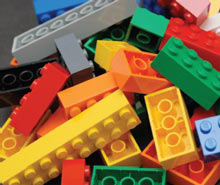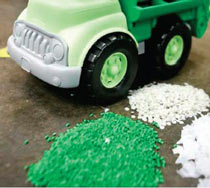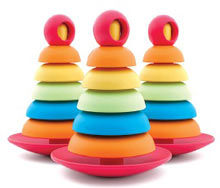Environment awareness is “child’s play”
Also, download this story from the electronic issue here
For eco-friendly toys, raising awareness for the environment need not take the fun out of playing with toys for children, says Angelica Buan in this article.
The holiday and festive season is coming soon and as usual, toys will top the shopping lists of most parents buying gifts for their children. But today’s consumers are no longer buying toys without being critical of the safety of designs and materials used. How toys will impact the environment at the end of life is also becoming an important basis for purchases.
Plastic has been a widely used materials for most toys in the market. According to the Valuing Plastic report commissioned by the Plastic Disclosure Project, with research conducted by natural capital analysts Trucost, and supported by the United Nations Environment Programme (UNEP), production of toys uses 48 tonnes of plastic per US$1 million in revenue annually. The natural capital cost of this plastic at US$3.3 billion/year represents 3.9% of revenue, suggesting that toy sector companies have the most opportunities, and at the same time, the most risks, from a business perspective, the report cited. A majority of the toy companies are “generally poor at disclosing their plastic footprint,” said the report.
On some occasions, old toys are passed down through generations. However the report stated that in the UK alone, 8.5 million new and useable toys ended up in landfills yearly. Recycling the toys is also becoming a challenge, owing to the various types of plastics they are made of or are combined into their production.
Nevertheless , toys are sure crowd drawers in shops. Market research firm Global Industry Analysts (GIA) projects the market to exceed US$135 billion by 2020. In its report, it stated that the largest market patron for toys and games is Europe, with the US being the fastest growing with a CAGR of 9.4% during the report period. By 2017, GIA forecasts that the Asia Pacific, led by China, will outperform the US market.
Toy manufacturers have since come up with innovations to keep up with the fast turnover of preferences – from traditional and mechanised to digitised toys. However, a number of toy makers are quick to tap on the emerging group of conscientious buyers who take the proactive approach to choosing eco-friendly products, and that include toys and playthings.

Building sustainable blocks
Denmark-headquartered Lego Group is investing an estimated US$150 million for a new sustainable materials centre that is expected to open in Billund, Denmark, by 2016. The research centre will study the feasibility of replacing the traditionally used acrylonitrile butadiene styrene (ABS)-based in its Lego blocks, with a more sustainable material by 2030.
The packaging for the toys will also have a materials makeover, according to Lego. Speaking for Lego, Roar Trangbaek said that a big portion of the firm’s carbon footprint emanates from the extraction and refinement of oil-based plastics, which are used in the blocks. The family-run Lego produces 60 billion blocks a year.
The Lego bricks’ transformation will not change the look and feel; and they will be made of plastic that is not petroleum-based, assured the company. Trangbaek also hinted about the possibility of utilising recycled plastics or biobased plastics.
Milk jugs turned into playthings
Meanwhile, US toy maker Green Toys is turning used plastic jugs into toys. The California-headquartered firm recycled more than 24 million jugs to obtain high-density polyethylene (HDPE) used in its ecofriendly toy line.

The firm’s rationale is that if the HDPE is safe for food contact applications, it is also safe to be used in children’s toys. Even the packaging used by Green Toys is made from recycled cardboard.
Bioplastics can be fun, too
Connecticut-based Luke’s Toy Factory makes toys from a combination of organic materials such as sawdust and clean certified plastic pellets. The uniquely designed toys have the handcrafted wooden-style appearance yet they are injection moulded to add safe colourants to the mix, at high speed rates, for quality. According to the firm, the toys are assembled by hand and use bioplastic material for the packaging, derived from sustainably farmed trees.

Meanwhile, Hong Kong-headquartered Bioserie makes baby products, such as teethers, stackers and rattles, using a special blend of polylactic acid (PLA) that contains no petrochemical additives.
According to Bioserie, the plant-based toys (the plant sources are annually renewable) do not contain oil-based chemicals. Hence, the toys are reputed as the world’s first baby toys that are certified 100% biobased by the US Department of Agriculture (USDA). The colouring used in the toys are specially developed for biopolymers ; and are based on sustainable raw materials, as well as meet several global industry and composting standards, including EN 13432 (European Union), ASTM D6400 (US), BPS GREENPLA (Japan) and DIN CERTCO (Germany), says Bioserie.
At play with algae
Algix, a clean technology company and producer of algae bio-products, in collaboration with Effekt, a material development company, recently introduced the world’s first algae-derived flexible foams for various applications, including toys, footwear, and sporting goods. The two firms have formed a joint venture, Bloom Holdings, to commercialise the foam under the brand Bloom. The foams contain anywhere from 15% to 60% algae component, depending on the formulation and application. Manufacturing will begin early 2016, in both the US and Asia.
Rob Falken, Effekt’s and Bloom Holding’s Managing Director, commented on the biobased foam: “For decades, flexible foams have been made out of nonrenewable petrochemicals. Over the past year we’ve worked really hard to create a suitable algae biomass alternative that does not compromise performance and that delivers tried–and–true characteristics for all sorts of demanding applications.”
Falken added that the foam is produced in a patented process that utilises Algix’s dried GMO-free algae biomass, which is solely collected from waste streams across the US and Asia.
Algal blooms have become prevalent worldwide due to a rise in global temperatures and a subsequent increase in water temperatures.
As well, they have been impacted by increasing human population growth and from activities like overfishing, which have increased nutrient loading in waterways. As a feedstock, algae biomass is a nonfood resource, requiring no pesticides to grow and is found in abundance globally, which bodes well for industries requiring its use.
(PRA)Copyright (c) 2015 www.plasticsandrubberasia.com. All rights reserved.









































